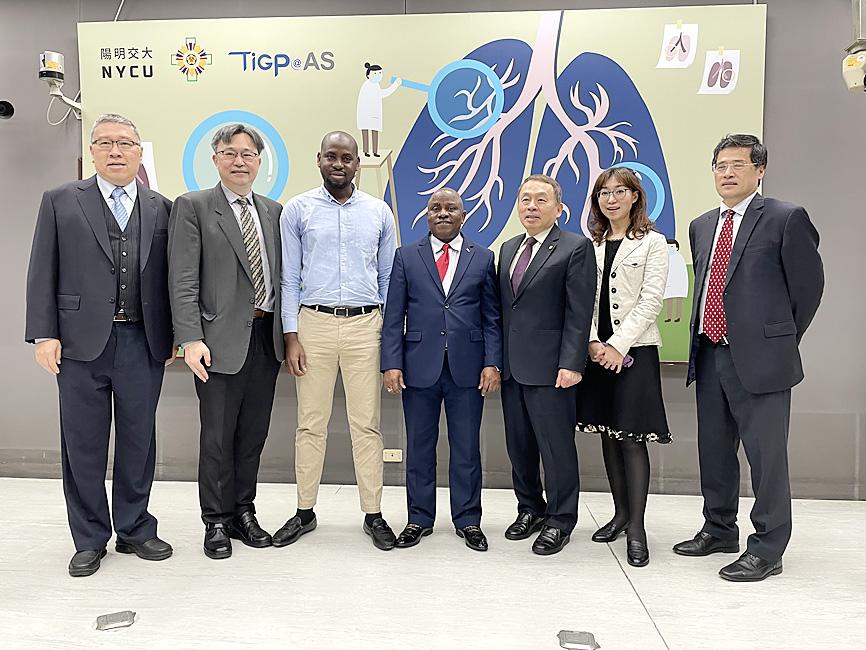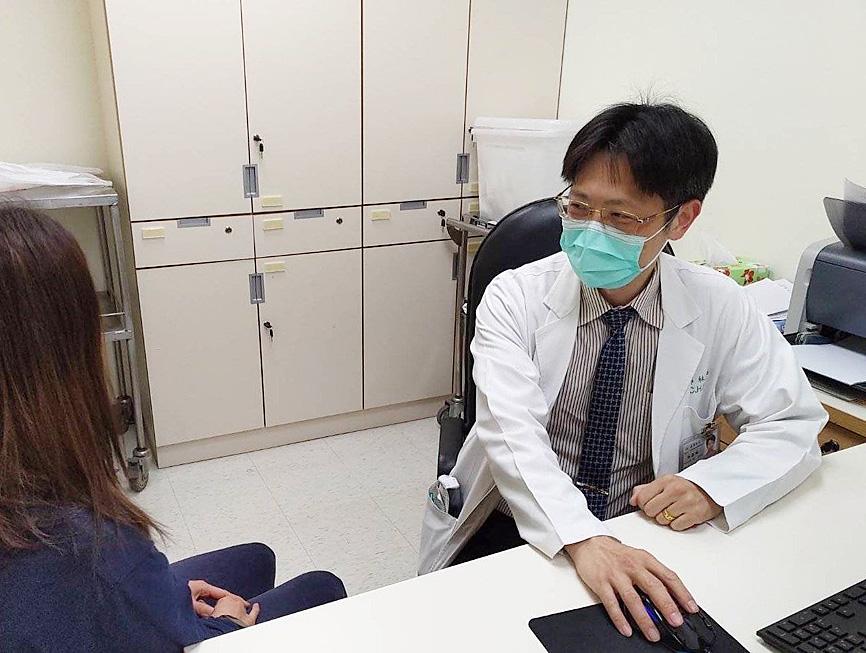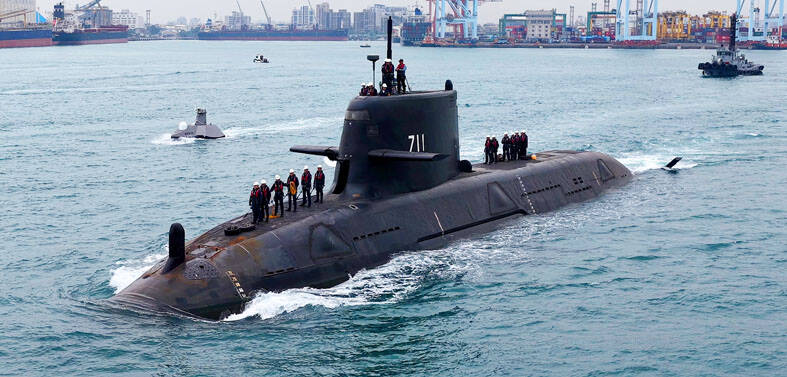A research team has developed a method to suppress the progression of non-small-cell lung cancer, potentially paving the way for a viable treatment of the disease, it said on Friday.
The team, which includes researchers from Taipei Veterans General Hospital and National Yang Ming Chiao Tung University, gene edited a type of oncogenic ribonucleic acid (RNA) known as C190.
C190 plays a key role in causing non-small-cell carcinoma, which is the cause of 85 percent of lung cancer cases.

Photo: CNA
By combining RNA editing and gene therapy, the researchers dissected the function of C190 and tested its potential as a therapeutic, reducing proliferation and migration of the cancer-causing cells and suppressing tumor growth, the team said.
While C190 is relatively stable and unlikely to mutate, it might become a useful biomarker for the development of treatments of lung cancer caused by non-small-cell carcinoma, said Chiou Shih-hwa (邱士華), director of the hospital’s research center.
Chiou said that C190’s attributes could contribute to better treatments than the most commonly used method, which targets epidermal growth factor receptor (EGFR), a protein.

Photo courtesy of Linkou Chang Gung Memorial Hospital
Abnormal activation of EGFR is one of the most important driving forces for the malignancy of cancers, said the team, which published its findings in the American Association for Cancer Research journal in January.
While there have been three generations of EGFR-related medicines developed for clinical treatment of non-small-cell cancer, innate or acquired drug resistance within 12 months of the drug being administered is a roadblock created by EGFR’s high mutability, the team said.
One of the most prevalent forms of non-small-cell cancer is lung adenocarcinoma, which accounts for a majority of such patients in Taiwan.
In a separate study, researchers showed that the risk of stroke and heart attack for people with type-1 diabetes is increased 2.61 times if one or more of their close relatives have type-2 diabetes.
The diabetes study, which was conducted by researchers and doctors at Linkou Chang Gung Memorial Hospital, was published in the JAMA Network Open online medical journal in December last year.
The Chang Gung researchers found that for a person with type-1 diabetes who has a close relative with type-2 diabetes, the risk of renal disorder is increased 1.44 times, retinal disorder is 1.28 times more likely and neurological disorders are 1.24 times as common.
Linkou Chang Gung Memorial Hospital said in a news release that type-2 diabetes is not well understood, as it is much less prevalent than type-1, with just 1 percent of the 2 million diabetic Taiwanese having the type-2 condition.
Lead author Lin Chia-hung (林嘉鴻), a physician at the hospital’s department of endocrinology and metabolism, said that their research was the first-ever large-sample study into the implications of family health history for people with type-2 diabetes in Taiwan.
The two forms of diabetes are caused by insufficient production of insulin in the pancreas (type-1) and insulin resistance at the cellular level (type-2), Lin said.
Lin said that he began investigating possible relationships between risk factors after previous studies pointed to a correlation between being related to a person with diabetes, and increased risk of hyperinsulinemia, which is linked to type-2 diabetes, and clogged arteries.
The team showed that there was a correlation after working with the hospital’s analytics center to produce a model from the health histories of more than 10,000 people aged 20 or older who were diagnosed with diabetes, he said.
The findings can help guide doctors to assess the health risks of people with either form of diabetes, and facilitate preventive measures and timely treatment, he said.

SHIPS, TRAINS AND AUTOMOBILES: The ministry has announced changes to varied transportation industries taking effect soon, with a number of effects for passengers Beginning next month, the post office is canceling signature upon delivery and written inquiry services for international registered small packets in accordance with the new policy of the Universal Postal Union, the Ministry of Transportation and Communications said yesterday. The new policy does not apply to packets that are to be delivered to China, the ministry said. Senders of international registered small packets would receive a NT$10 rebate on postage if the packets are sent from Jan. 1 to March 31, it added. The ministry said that three other policies are also scheduled to take effect next month. International cruise ship operators

NUMBERS IMBALANCE: More than 4 million Taiwanese have visited China this year, while only about half a million Chinese have visited here Beijing has yet to respond to Taiwan’s requests for negotiation over matters related to the recovery of cross-strait tourism, the Tourism Administration said yesterday. Taiwan’s tourism authority issued the statement after Chinese-language daily the China Times reported yesterday that the government’s policy of banning group tours to China does not stop Taiwanese from visiting the country. As of October, more than 4.2 million had traveled to China this year, exceeding last year. Beijing estimated the number of Taiwanese tourists in China could reach 4.5 million this year. By contrast, only 500,000 Chinese tourists are expected in Taiwan, the report said. The report

Temperatures are forecast to drop steadily as a continental cold air mass moves across Taiwan, with some areas also likely to see heavy rainfall, the Central Weather Administration (CWA) said. From today through early tomorrow, a cold air mass would keep temperatures low across central and northern Taiwan, and the eastern half of Taiwan proper, with isolated brief showers forecast along Keelung’s north coast, Taipei and New Taipei City’s mountainous areas and eastern Taiwan, it said. Lows of 11°C to 15°C are forecast in central and northern Taiwan, Yilan County, and the outlying Kinmen and Lienchiang (Matsu) counties, and 14°C to 17°C

STEERING FAILURE: The first boat of its class is experiencing teething issues as it readies for acceptance by the navy, according to a recent story about rudder failure The Hai Kun (海鯤), the nation’s first locally built submarine, allegedly suffered a total failure of stern hydraulic systems during the second round of sea acceptance trials on June 26, and sailors were forced to manually operate the X-rudder to turn the submarine and return to port, news Web site Mirror Daily reported yesterday. The report said that tugboats following the Hai Kun assisted the submarine in avoiding collisions with other ships due to the X-rudder malfunctioning. At the time of the report, the submarine had completed its trials and was scheduled to begin diving and surfacing tests in shallow areas. The X-rudder,